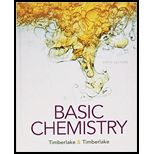
(a)
Interpretation:
A strip of magnesium metal dissolves rapidly in 6.00 mL of a 0.150 M HCl solution, producing hydrogen gas and magnesium chloride.
Assign oxidation numbers to all of the elements in the reactants and products.
Concept Introduction:
Here are the rules for assigning oxidation number to elements:
- For an element in its free state it is assigned an oxidation number of zero.
- Monatomic ions have oxidation number that is equal to charge of the monatomic ion.
- Alkali metals have +1 oxidation number, alkaline earth metals have +2 oxidation number and halogens are assigned -1 oxidation number.
- In most compounds H is assigned a +1 oxidation number and O is assigned a -2 oxidation number.
- For a neutral compound the summation of oxidation numbers of all elements in the compound is zero.
If the oxidation number of an element increases then it undergoes oxidation and if the oxidation number of the element decreases then it undergoes reduction.
(b)
Interpretation:
To write the balanced chemical equation for the reaction.
Concept Introduction:
In a balanced chemical equation for a reaction the number of atoms of each element is equal on both side of the reaction.
(c)
Interpretation:
To find the oxidizing agent.
Concept Introduction:
An oxidizing agent itself gets reduced as it oxidizes other substances. An oxidizing agent accepts electrons.
(d)
Interpretation:
To find the reducing agent.
Concept Introduction:
A reducing agent itself gets oxidized as it reduces other substances. A reducing agent losses electrons.
(e)
Interpretation:
To find the pH of the 0.150 M HCl solution.
Concept Introduction:
(f)
Interpretation:
To find the grams of magnesium that can dissolve in the HCl solution.
Concept Introduction:
Want to see the full answer?
Check out a sample textbook solution
Chapter 16 Solutions
Basic Chemistry - With Access
 ChemistryChemistryISBN:9781305957404Author:Steven S. Zumdahl, Susan A. Zumdahl, Donald J. DeCostePublisher:Cengage Learning
ChemistryChemistryISBN:9781305957404Author:Steven S. Zumdahl, Susan A. Zumdahl, Donald J. DeCostePublisher:Cengage Learning ChemistryChemistryISBN:9781259911156Author:Raymond Chang Dr., Jason Overby ProfessorPublisher:McGraw-Hill Education
ChemistryChemistryISBN:9781259911156Author:Raymond Chang Dr., Jason Overby ProfessorPublisher:McGraw-Hill Education Principles of Instrumental AnalysisChemistryISBN:9781305577213Author:Douglas A. Skoog, F. James Holler, Stanley R. CrouchPublisher:Cengage Learning
Principles of Instrumental AnalysisChemistryISBN:9781305577213Author:Douglas A. Skoog, F. James Holler, Stanley R. CrouchPublisher:Cengage Learning Organic ChemistryChemistryISBN:9780078021558Author:Janice Gorzynski Smith Dr.Publisher:McGraw-Hill Education
Organic ChemistryChemistryISBN:9780078021558Author:Janice Gorzynski Smith Dr.Publisher:McGraw-Hill Education Chemistry: Principles and ReactionsChemistryISBN:9781305079373Author:William L. Masterton, Cecile N. HurleyPublisher:Cengage Learning
Chemistry: Principles and ReactionsChemistryISBN:9781305079373Author:William L. Masterton, Cecile N. HurleyPublisher:Cengage Learning Elementary Principles of Chemical Processes, Bind...ChemistryISBN:9781118431221Author:Richard M. Felder, Ronald W. Rousseau, Lisa G. BullardPublisher:WILEY
Elementary Principles of Chemical Processes, Bind...ChemistryISBN:9781118431221Author:Richard M. Felder, Ronald W. Rousseau, Lisa G. BullardPublisher:WILEY





